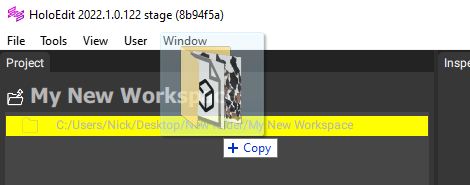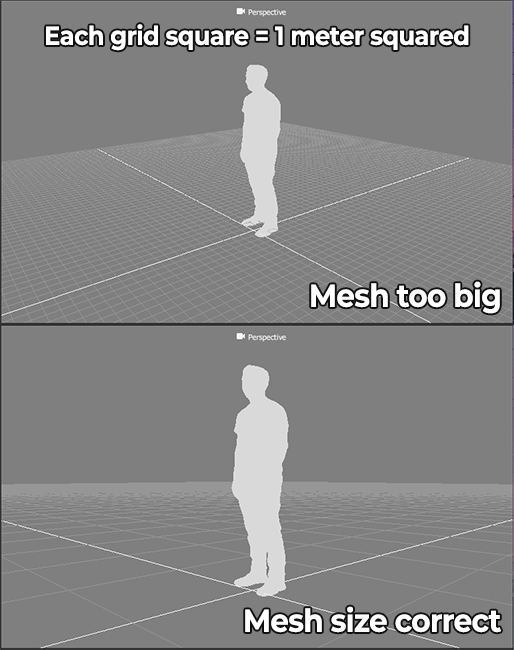HoloEdit 2022.1.0 Release Notes¶
New Features¶
Texture Transfer Using Closest Point¶
Closest Point has been added to the Texture Transfer stage as a new method of re-texturing modified meshes. This new method is more capable of transferring textures accurately in small areas where opposing mesh surfaces are in close proximity.
In general this approach should yield better results than the previous Raycast method, and as such it has been made the default method for texture transfer. Raycast is still available and can be selected if desired.

New Generate UVs Stage Added to HoloEdit¶
Generate UVs has been added to HoloEdit as a brand new stage. This stage allows you to generate new UVs for a mesh regardless of whether it already had any. Using this in conjuction with the Remesh and Texture Transfer stages allows you to effectively rebuild meshes from the ground up with a topology consistent for use in HoloEdit.
Parallelization of Job Asset Uploads¶
The process has been threadded when uploading assets to our cloud computing servers. This should result in a dramatic (10x) increase in the speed at which assets can be uploaded from your computer. Please note that this is still subject to the limits of your network connection speed.
Drag-and-Drop Support Added to Project View¶
Volumetric Clip source files can now be added to HoloEdit by dragging and dropping them into the Project window. The dragged item needs to be dropped in the folder hierarchy, which will be previewed as you hover over the window.

Rename and Delete Content From HoloEdit Project View¶
Content and Saved Compositions can now be renamed and deleted from within HoloEdit. When right-clicking on an item in the Project view, select the Rename or Delete option. After clicking Delete, a confirmation window that will appear requiring you to approve the deletion. Note that deletion is a permanent operation that cannot be reverted.
Unreal Engine HoloSuite Plugin VR Support¶
Support has been added to the Unreal Player for VR devices such as the Oculus Quest. Two new maps have been added to our Unreal Player demo project:
A Minimal VR scene containing only an OMS clip
A VR-ready version of our Demo Room
There are additional steps to configuring an OMS Player for VR, so please be sure to check out the newly added Unreal VR walkthrough page.
Also please note that there is a known performance issue when trying to include more than one OMS Player on a map at the same time, which will (likely) result in inconsistent playback. We are working to address this and will provide an update when the issue is resolved.
Fixes¶
Texture Reconstruction Tasks Display As Failed¶
This was called out as a known issue in HoloEdit 2021.2.2, and has been fixed in this version. Texture Reconstruction tasks now report properly (and as such any error encountered should be taken at face value).
Timeline Visual Errors¶
A small number of visual issues with the timeline have been corrected in this release. This had no impact on the functionality of the timeline, but when present made the timeline harder to read correctly. It’s unlikely you have encountered these issues, and now you’ll never have to.
Cloud Processing Service Improvements¶
Fixed a pair of rare bugs in the cloud processing environments. The first could result in a small number of work units that would never be processsed, leaving a job hanging on 99% completion. The second could lead to the creation of zombie jobs that would appear in the job viewer, but effectively did not exist.
Multi-Stage Job Could Process Out Of Order¶
It was possible for jobs that were processing multiple stages to incorrectly wait for results from a preceding stage before beginning work. This has been fixed.
Known Issues¶
UV Generation Does Not Reserve Space for Frame Encoding¶
If a mesh’s UV map contains islands that are too close to the bottom-right of the UV space, it is possible that the frame encoding will overwrite texture space within the island, and thus produce small black and white spots during playback. This issue can occur with source volumetric assets as well and not only our generated UV sets. A fix is planned for this which should address all instances of this problem.
HoloEdit Crashes When Referencing Deleted Clips¶
If a Clip was used in a saved compostiion (manually or via autosave) and is then later deleted from the Project library, this will lead to HoloEdit crashing when attempting to reference the clip. This can happen in two ways:
Open the composition - If selecting a stage that references the clip, HoloEdit will crash. Additionally, when the composition is closed it will also cause HoloEdit to crash during a cleanup step.
Using the Manage Workspace tools - Since the tools will scan all compostions marked for deletion and asset references within them, this will also cause HoloEdit to crash.
It is recommended that you use Manage Workspace to clean up old compositions you no longer want before deleting an asset from the Project library.
Unreal VR Builds Cannot Load Multiple Clips At The Same Time¶
When more than a single OMS Player is loaded at once, there is a high probability that they will not play correctly. This issue seems far less common in Unreal 4.25, and manifests differently in 4.26 and 4.27, and this is actually observable using our included VR DemoRoom map.
We’re working to optimize the plugin and will release a patch once this playback problem is solved. Until then, it is strongly recommended you only use a single OMS player at a time in your VR experience.
Rare SSDR Job Faliure In Short Segments¶
There is a rare situation where the SSDR processor can fail on segments that are 2-frames in length. Re-running the job will not change the result as the cause - while unidentified - is known to be an attribute of the inputs. Please understand that this issue is not critical, because SSDR requires at least three frames in a segment before it offers a compression savings. As such, while frustrating that these jobs failures are occurring, they do not negatively impact your final clip. All the same, we appreciate the stress and inconvenience that running into this issue can cause, and will fix it.
Windows 11 Update Invalidates Held License¶
This issue is the result of the Windows update causing the computer to look like a different one than the license is currently assigned to. Licenses are automatically released after 24 hours, at which point the licenese can be re-acquired and everything will work fine again. Unfortunately to perform this action any sooner requires contacting our support team.
It is recommended that you release your HoloEdit license before updating to Windows 11 as this will sidestep the issue entirely.
Windows 11 Local Job Server additional warnings¶
On Windows 11 when running the local job server, the log will constantly return failed to get access token and failed to get compute time along with another two lines which reference “payment”. Using the local job server does not comsume compute time - you can still run jobs and it will not eat into your compute time balance. This notification is effectively harmless and you are still able to run jobs on the local server.
Sign-out > Sign-in Required for Streaming-Type Exports When Using Local Server¶
Due to an issue where the account compute balance is not fetched if HoloEdit is started with the local job server active, Streaming-type exports cannot be initiated until the user account is signed-out and signed-in again, or the application is restarted with the Remote job server active.
Mesh Capture Tool First MVE Camera Capture Error¶
Unfortunately due to a timing issue with shader compilation in Unity 2019, the first MVE camera capture takes place before the model is correctly textured. This will be addressed in another version, however for now a workaround does exist within Unity:
Open the Mesh Capture Tool project
Edit > Project Settings > Editor
Scroll to the bottom and find the Shader Compilation section
Disable Asynchronous Shader Compilation
Web Player Texture Size Limitation (1440x1440)¶
The streaming content using the web player, textures larger than 1440 are not supported. Thus you cannot play quality profiles that use higher resolution textures. If a streaming clip contains no quality profiles with textures 1440 or lower then playback will be impossible and it will appear as though the clip is broken.
Please note this does not affect playback when streaming using the Unity player.
Large-Scale Clips Generating Bad Skeletons and SSDR Results¶
A “large-scaled volumetric clip” can be identified using the grid visible in HoloEdit:

Where each grid block represents one square meter of space, a “standard-sized” model would visibly fit within one square when upright. If your model is significantly larger than this (100x or more) the Generate Skeleton process will likely produce no visible result, and SSDR is likely to encounter precision errors resulting in bad visual noise during playback.
You can work around this by re-sizing your meshes within HoloEdit and then using File > Export Composition to export the meshes, then reimport them as a new clip that will use the correct scale.
Local Job Server Conflict When Already Running Node.js¶
The local job server uses Node.js to connect with HoloEdit for receiving jobs. Unfortunately this can conflict with an existing instance of Node.js you may be running for your own processes. At the moment there is no work around for this - either Node.js has to be uninstalled from the machine before you run the local job server first time setup, or you cannot use the local job server.
We apologize for the inconvenience at this time, and a fix will be available in a later release.
Compare View Mode Poorly Handles There Only Being Visible Data On One Stage¶
There are several display bugs tied to this case, however as you would typically be using Compare to review processed data with its source or an earlier stage, this is an outlier behaviour and you likely will not encounter it.
OMS Header Corrupt in Files Using SSDR and Retargeting Exported Before HoloSuite 2021.2.0¶
Most tools do not activley use this information, so it is unlikely to have previously caused any issues. However if an OMS with dynamic retargeting was previously working and suddenly develops a problem, this is likley the culprit.
The good news is that fixing this only requires you to import the OMS into HoloEdit, and then re-export it. The header will be regenerated and correctly exported from versions 2021.2.0 and newer.